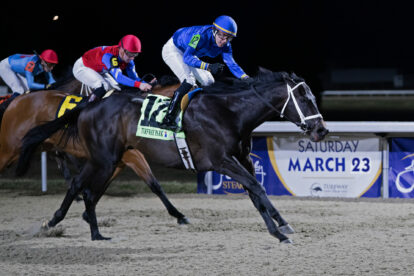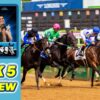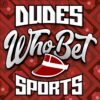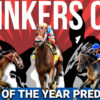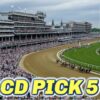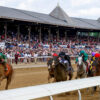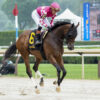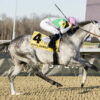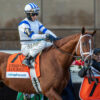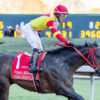Dr. Miranda explains why she thinks Encino will win the 2024 Blue Grass Stakes (G1) at Keeneland Racetrack, a prep race for the Kentucky Derby (G1).
Do you agree with Dr. Miranda’s opinion? Tell us YOUR thoughts in the Comments!
SMASH the *Thumbs Up* ~ HIT *Subscribe* ~ RING the *Notification* bell
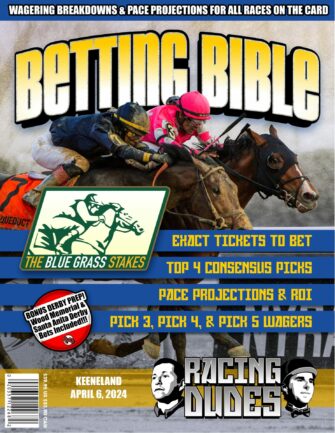
Blue Grass 2024 Betting Bible
Get the 2024 Blue Grass Betting Bible, featuring our EXACT wagering plans at Keeneland on April 6, 2024! Record ROI for the 2024 Louisiana Derby Day!
BONUS: Get Wood Memorial and Santa Anita Derby bets, too!
The press release:
Godolphin’s Encino, winner of the John Battaglia Memorial (L) at Turfway Park in his most recent racet, turned in his second Keeneland work Saturday morning in preparation for an expected start in next Saturday’s $1 million Toyota Blue Grass (G1) with a 5-furlong breeze in 1:01.
Working with stakes-placed Tapit Shoes, Encino posted fractions of :23.80, :37.80, :48.60 and 1:01 over the fast main track. Encino worked the same distance in 1:01.80 last Saturday in company with Tapit Shoes.
“It was a pretty straightforward work, like last week,” said Tessa Walden, assistant to trainer Brad Cox.
Saturday’s Toyota Blue Grass (G1) is part of a new wager called the Big 3 Pick 3.
The wager also includes the $750,000 Wood Memorial (G2) Presented by Resorts World Casino from Aqueduct and the $750,000 Santa Anita Derby (G1). All three races are contested at 1 1/8 miles and offer 100-50-25-15-10 Kentucky Derby (G1) qualifying points to the first five finishers.
The Big 3 Pick 3, which includes a mandatory payout, is offered with a base wager of $3 and 19% takeout. Hosted by Aqueduct, the Big 3 Pick 3 will appear as a separate wager/track on your wagering machine or online account: Big 3 Pick 3.
The Lexington Bowl, a priceless link to the history of the Turf in Central Kentucky, will make an appearance Saturday for the 100thrunning of the $1 million Toyota Blue Grass (G1). The winning connections will see the historic piece on display in the Directors Room for their celebration.
Part of Keeneland Library’s collection, the Lexington Bowl dates from 1854 when it was manufactured by the local silversmith firm Garner & Winchester to be presented to Dr. Elisha Warfield by the citizens of Lexington to honor the great Lexington, a horse he bred who was the finest runner of his day and became a 16-time leading sire. Warfield, a physician, owned The Meadows farm, which bordered the Kentucky Association track near downtown Lexington. He had been a founding member of the Kentucky Association in 1826.
After Warfield’s death in 1859, daughter Mary Jane Warfield Clay (wife of Cassius Marcellus Clay) inherited the Lexington Bowl. It passed to her son Brutus J. Clay II. Clay died in 1932, leaving the bowl to his daughter, Mrs. Edward D. Johnson. During the early winter of 1937, Clay’s widow, Lalla Rookh Fish Marsteller, purchased the bowl from her stepdaughter.
The Blue Grass Stakes, named for the famous Bluegrass region of Central Kentucky, was inaugurated in 1911 at the Kentucky Association track. The race was run there through 1914 and again from 1919-1926.
With the demise of the Kentucky Association track, a group of prominent area Thoroughbred breeders were busy working to return Thoroughbred racing to Lexington and national importance. In 1935, they founded the Keeneland Association, purchased land from horseman J.O. “Jack” Keene and set out to open a model race track. Keeneland opened Oct. 15, 1936, for nine days of racing. In April 1937, Keeneland held its inaugural Spring Meet of 11 days and ran the Blue Grass for the first time on April 29.
The winner of the first Blue Grass here was Fencing, who won by three-quarters of a length over the favored duo of Billionaire and Brooklyn, who were noses apart for second.
Meanwhile, Thoroughbred Record announced the Lexington Bowl had been purchased by “three nationally known sportsmen, who asked their names be withheld” to be used as a presentation trophy beginning in 1937 for the winning owner of the first Blue Grass at Keeneland. (The buyers likely were industry stalwarts Arnold Hanger, whose purchase of a collection of books about the Turf led to the creation of Keeneland Library; John Hay “Jock” Whitney; and future Keeneland President Louis Lee Haggin II.)
The names of the Blue Grass winners were etched onto the Lexington Bowl as of 1937, and Keeneland used the piece as a presentation trophy from 1937-1952. In 1953, the track instituted gold juleps and no longer presented the Lexington Bowl.
Keeneland never had duplicates of the Lexington Bowl made for winning owners to keep, but at least two prominent owners commissioned replicas for their personal trophy collections. Lucille Parker Wright (Markey) of Calumet Farm and Elizabeth Arden of Maine Chance Farm both commissioned Tiffany & Co. to create replicas for their respective Blue Grass winners: Bull Lea (1938) and Lord Boswell (1946).

